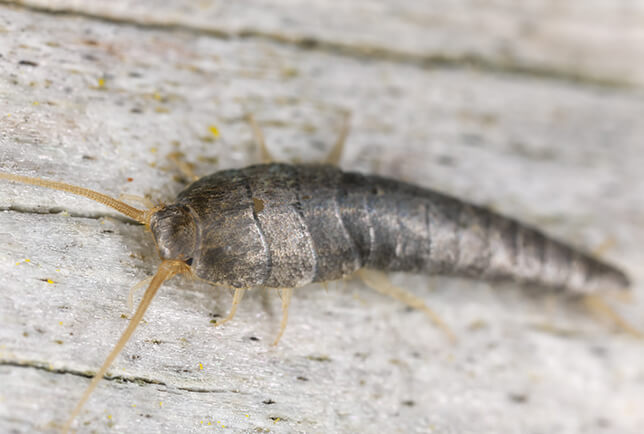What Do Silverfish Look Like?

Silverfish, also known as bristletails, are a nuisance in both New England homes and businesses. These pests have a flat, carrot-shaped body covered in grayish-silver scales with a distinct metallic sheen. Excluding the three long filaments at the base of the body and their antennae, the insects are about a half-inch in length.
How Can I Tell if I Have a Silverfish Problem?
Silverfish are active at night. You rarely see them during the day unless they are disturbed. The insects can live for around three years, and females lay many eggs during their lifetime. Some common signs of an infestation are:
- Movement – Exposing the pest’s hiding places in basements, garages, or closets will send the insects scurrying rapidly to find another cool, shaded hideout.
- Damage – As silverfish feed, they leave a series of holes in books, fabric, and garments.
- Waste – The pests often leave droppings near or on their food sources.
- Cast Skins – Nymphs molt many times as they mature. Finding numerous cast-off skins is cause for concern.
How Do Silverfish Get Inside Homes and Businesses?
As silverfish are thin and flat, it’s easy for them to crawl under doors and fit through cracks in foundations. Boxes brought inside from infested storage areas can bring silverfish into homes as well. The glue used to bind books is part of the silverfish diet, and an infestation may start within the pages of few second-hand novels.
Commercial buildings offer silverfish even more entry points. Retail locations with loading docks give the pests easy access, and they come in through cardboard shipping boxes, too. Silverfish can also get inside supermarkets or pet supply stores in cat and dog food or by traveling along pipes and wiring in the walls.
Are Silverfish Dangerous?
While silverfish don’t pose serious health concerns for people, they do harm property. The pests’ waste contaminates sugar, flour, and other stored grains, resulting in costly food losses. Silverfish also feed on cotton shirts or garments with food or drink stains. In addition, infestations can continue for years, as female silverfish never stop laying eggs once they mature.
A silverfish infestation may have one potential positive side. The pests’ presence often alerts property managers and homeowners to plumbing leaks, as silverfish need moisture to survive.
On the other hand, the pests eat glue and paper, so libraries, bookstores, and similar enterprises may see expensive losses. In museums and historic buildings, silverfish damage can affect irreplaceable books and authentic costumes, etchings, photographs, and other artifacts.
How Can I Prevent Silverfish Infestations?
Keep pet food, sugar, and cereal in airtight containers. Ensure plumbing is in good repair to reduce moisture. Since they can hide almost anywhere and only feed at night, silverfish are difficult to control on your own. Contact Waltham Pest Services today to consult with our expert staff.